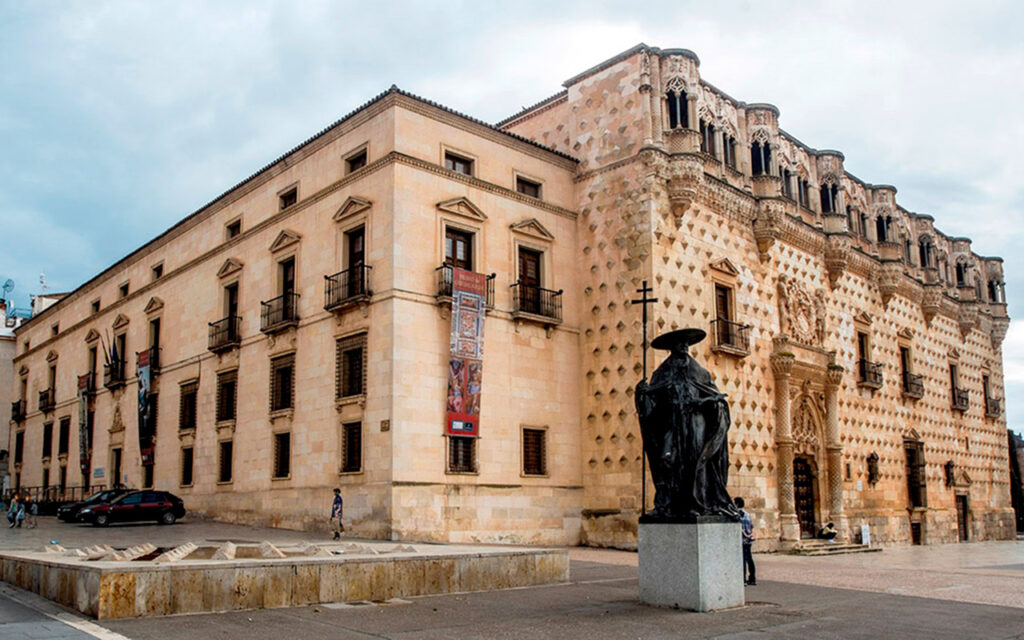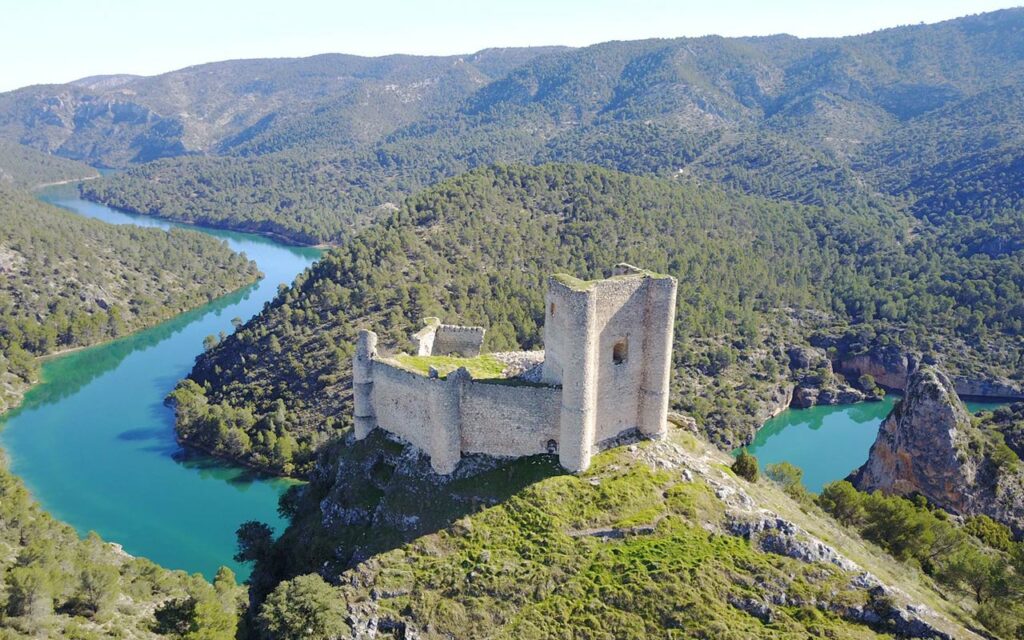Guadalajara
The circuit is located 10 minutes from Guadalajara capital, where we find different tourist and leisure offers. Located on the banks of the Henares River, 56 km from Madrid and 21 km from the circuit, it is one of the great unknowns in Spain, it has numerous and interesting attractions that you can enjoy. Among all of them we highlight:
- Infantado Palace: Work of Juan Guas, it is the most beautiful building in the capital, the palace of the Dukes of Infantado, described as “unique of its kind” and noted as a peculiar example of universal art, designated as a World Heritage Site. In addition to its main façade with diamond tips, the Patio of the Lions and Palace Gardens are worth highlighting. Inside, and as an exhibition space, we also find the Museum of Guadalajara.
- Saint Mary's Co-Cathedral: In this church, whose origin dates back to the end of the 13th century or the beginning of the 14th century, three main styles occur: Mudejar, Renaissance and Baroque.
- Convent of La Piedad and palace of Antonio de Mendoza. Complex formed by the palace of the knight Antonio de Mendoza and the church of La Piedad, today rehabilitated as the Liceo Caracense High School Institute. The palace was designed by Lorenzo Vázquez and built around 1510. In 1525, the construction of the church began, under the direction of Alonso de Covarrubias.
- Foundation and Pantheon of the Countess of Vega del Pozo: María Diega Desmaissières, Duchess of Sevillano, Countess of Vega del Pozo, promoted one of the best architectural complexes of the late 19th century, commissioning Ricardo Velázquez Bosco to construct a vast complex of buildings, intended for charitable establishments and a family pantheon .
www.guadalajara.es/es/turismo

Sacedon
In the Tagus Valley and next to the Entrepeñas Reservoir, Sacedón was known as the Sea of Castile, it is shown to us as a typically Alcarreña town. It is located 36 km from the circuit.
- Our Lady of the Assumption: It stands out for its slender tower and appears in the story of the Journey to Alcarria by Camilo José Cela; Its Renaissance façade and transitional Gothic interior also stand out.
- Hermitages such as that of the Holy Face of God, San Juan Bautista or the hermitage of Nuestra Señora del Socorro: Surrounded by dense forests and overlooking the Tajo gap and the hermitage of San Andrés, on the edge of the swamp.
- The hill of La Coronilla: It offers us an impressive view and the Monument to the Heart of Jesus, more than 20 meters high.
- Cistercian Monastery of Santa María de Monsalud: One of the most important medieval monasteries in its surroundings, the oldest and best preserved. The visitor will be able to enjoy all its rooms from the cloister to the refectory, passing through the kitchens and cellars.
- Entrepeñas Dam: On the Tagus River and from where we can enjoy magnificent views and a wide variety of outdoor activities, as well as water sports.
www.turismosacedon.com

Brihuega
On the banks of the Tajuña River we find this monumental town, declared a Historic-Artistic Site. It is located 32km from the circuit.
- Gates and wall: Brihuega was a walled town, of which some paintings and two of its doors are preserved today. The Arco de Cozagón, located near the bullring, and the Cadena, on the opposite side, next to the María Cristina park.
- “Peña Bermeja” Castle: The defensive system of the town ended with this castle, named after the red stone of the fortress that dominated the Tajuña valley. Curiously, inside the castle is the town's cemetery.
- Church of Santa María de la Peña (13th century), where the patron saint of Brihuega is located.
- Plaza del Coso: Main square of the town where we find the old Royal Jail of Carlos III (today the Tourist Office), the historical archive, the Town Hall (1975) and the so-called “Arab Caves” (10th century). These caves of several kilometers were a defensive system in case of siege to be able to hide or move around the town.
- Royal Cloth Factory (1787): It once had 84 looms in which around a thousand employees worked. It is worth taking a walk through its Versailles-style gardens and enjoying the views of the Tajuña valley.
- Professor Max's Museum of Miniatures: Illusionist and natural magician from Brihuega, whose collection includes 65,000 pieces of miniatures of everyday objects from different periods, as well as dolls' houses and buildings on a tiny scale.
- Lavender fields: It is one of the landscapes that in recent years has been attracting thousands of tourists every beginning of summer. In the local fields, large areas of lavender and lavender are grown for cosmetic companies, leaving a beautiful landscape in a violet tone, unique in Spain.
- Civic: Heading towards the town of Masegoso de Tajuña, next to the road we find this curious place. It is a small urban complex, covered with vegetation, streams and waterfalls, among which architectural elements such as stairs, terraces, arches and doors can be seen.
www.turismobrihuega.com
Pastrana
Located 26 km from the Armuña circuit, town of the Princess of Éboli, it is the epicenter of the Alcarria region, being a historical, cultural and heritage reference; In 1966, Pastrana was declared a Historical-Artistic Site.
- Pastrana Parish Tapestry Museum: Its museum houses the most important Flemish Gothic tapestries in the world from the late 15th century. Liturgical ornaments, carvings and Renaissance paintings are also on display. You can also visit the pantheon of the Dukes of Pastrana, a work from the 17th century, where the remains of the Princes of Éboli and the Dukes of Infantado rest.
- Museum of Saint Teresa: 1.5 km from Pastrana, is the Convent of Carmen, formerly the Convent of San Pedro founded in 1569 by Saint Teresa of Jesus. It houses the entire artistic history (pictorial and sculptural) of the monastery from its beginning in the 16th century until its disappearance. , due to the confiscation, in 1836.
- Walking tour through the medieval town of Pastrana: The best way to discover Pastrana is on a walk along its ancient cobblestones, passing under the Arch of San Francisco and walking through its labyrinth of alleys and passageways. Admire the house where Leandro Fernández de Moratín wrote some of his most famous plays. Also the House of the Dean, the Fuente de los Cuatro Caños is an emblem of the town: a large stately fountain from the same era as the princess of Éboli. The ancestral houses and mansions of nobles. The House of Knight Calatravo; the Palace of Burgos, we can also see what was the house of the Holy Inquisition.
- The little Albaycin de Pastrana: Neighborhood built by the Moors who settled on the outskirts of Pastrana.
www.pastrana.org
Zorita de los Canes
Zorita de los Canes (37 km), located in a curve of the Tagus, has its origin in the Visigothic city of Recopolis. The current municipality has Arab origins and was supplied with materials from the ancient ruins for its construction.
The castle rises above the town and the rock and its ruins contemplate the passage and union of the cultures that populated it, as well as the remains of coexistence in their residential, military or religious activity and remnants of supplies such as wells and the cistern But it is the Recópolis Archaeological Park that sustains the greatest interest of this population. These are the remains of the only known Visigothic city in Europe. The tour
of the park allows us to travel from the 6th to the 17th century, through the Visigoths, Andalusians and
Christians.
www.zoritadeloscanes.com
Buendia (Cuenca)
Buendía, 52 km from the circuit, in the Alcarria region, next to the Sierra de Altomira and the reservoir that bears his name, houses charms that are worth a visit. It has a medieval aroma that filters through its wall surrounding it in its remaining sections. In the urban fabric, its Plaza Mayor stands out, siamese with Ruiz Jarabo, both arcades with semicircular arches on square pillars.
The church of Our Lady of the Assumption It captains the architectural complex of the Plaza Mayor, from Gothic to Renaissance, it contains examples of various styles and its Herrerian façade is of great beauty. La Tercia, a 15th century warehouse built of masonry and ashlar, houses the carriage museum. The rest of the visit mixes art and nature and even engineering when referring to the Buendía reservoir dam.
The hermitage of the Virgin of the Forsaken It stands out above all for its location. But where the landscape surrounds art or, rather, art comes to sneak into nature, it is on the Route of the Faces; a path marked by sculptures taken from the rocks in a landscape of pine forests. Made by different authors, they create a natural museum and an unparalleled path.
www.ayuntamientodebuendia.com

